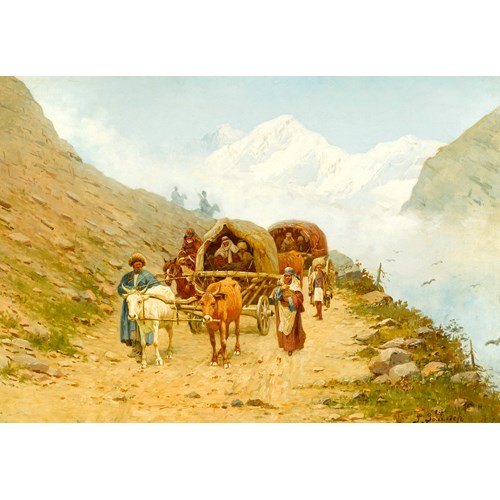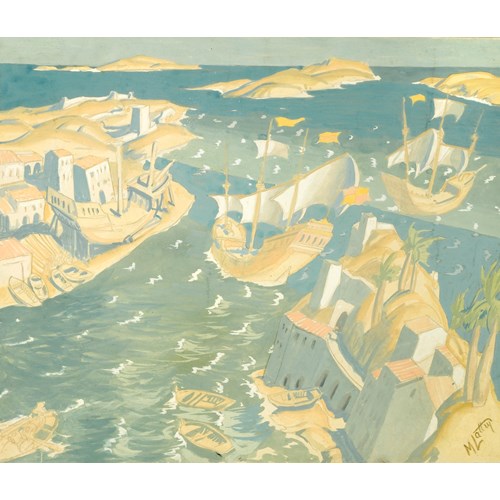School Flemish
Portrait of a Lady
Date 1535
Period 1400-1600, 16th Century
Origin Belgium
Medium Oil on panel
Dimension 48 x 40 cm (18⁷/₈ x 15³/₄ inches)
Infra-red images of this portrait reveal a contrast between the precision with which trompe-l’oeil setting has been depicted, and the fluid brush work with which the sitter has been painted. The images also show that the artist made several changes during the painting process, most significantly in relation to the position of the sitter’s hands. Originally the woman’s right hand was much higher, whilst her left remained low down on her stomach. It appears as if originally the sitter may have been cradling her stomach in a manner which possibly suggests she was pregnant. If this was the case, the present painting would have been a rare, although by no means unique, example of a woman being portrayed as unambiguously pregnant in sixteenth-century painting.¹ It is impossible to know for certain if this was the artist’s original intention, or the reasons behind the change of the hands’ position, but the finished work depicts the sitter in a more traditional manner holding the pomander.
The portrait was probably originally one half of a diptych, most likely facing either a portrait of the sitter’s husband or, less likely, a religious scene, such as a Virgin and Child or a Crucifixion.² Although the other wing has yet to be identified, in religious diptychs the subject of the portrait half will generally show some sign of their devotion; for example their hands are often clasped in prayer, or they might hold a prayer book or rosary. However, the sitter in our work has no spiritual accoutrements, and instead prominently displays a pomander decorated with pearls, a deliberate show of wealth. Indeed the popularity of portrait diptychs ‘may be linked to an increasingly numerous and prosperous middle class that appeared in the Netherlands in the fifteenth century.³ Unfortunately it is extremely common for the two halves of a diptych to be separated but when they are reunited one can see how Flemish artists used devices, such as fictive architecture, to ensure that the two halves would relate to each other.
The identity of the sitter in our painting is currently unknown. Her costume is very close to those worn in two of Hans Holbein II’s portraits, in the Kunsthistoriches Museum in Vienna, and the Detroit Institute of Arts (inv. no. 77.81). Although both of these portraits date from Holbein’s time in England, the costumes worn are in fact more typically Flemish. The clothing worn in Flemish portraiture of this period tends to be relatively restrained and understated which can often make identification of sitters extremely difficult. As previously mentioned, it is clear that our sitter was a woman of some wealth. However, unless the other half of the diptych resurfaces and provides further clues to her identity, she is likely to remain anonymous.
The painter of this portrait remains elusive, although it is clear they drew on a number of influences from across Europe. Such is its quality, that for a period it was believed by several scholars, including Max Friedländer, to have been painted by Holbein.⁴ However, numerous features, both technical and stylistic, when considered together, suggest that a Flemish painter is more likely. The oak panel and rounded top are typical, although by no means exclusive, to Flemish painting of this period. Stylistically, the painting draws on the influence of some of the leading Flemish painters of the period and it is worth noting that it was once thought to be by Jan Gossart. Certainly the integral role played by the architecture in this painting is typically Flemish, but in particular is reflective of Gossart’s influence. Architectural features played ‘a primary role’ in Gossart’s art, with many of his paintings featuring prominent antique forms and ornamentation, indications of power and authority.⁵ As the foremost Netherlandish artist of the period his influence on the work of his contemporaries was considerable, including the painter of our portrait. The architectural setting, tromp l’oeil frame, and use of animating putti in our painting, are all part of this artistic tradition.
Due to its obvious quality, over the years this portrait has accumulated a notable provenance. 1st Viscount Rothermere seems to have assembled much of his magnificent collection during the late 1920s and early 1930.⁶ In addition to the present work it included works by Guardi, Rubens and, perhaps most notably, the Burrell Collection’s Rembrandt self-portrait.⁷ Before entering the Rothermere collection, our portrait belonged to 3rd Marchioness Conyngham. It is unclear for how years it was part of the Conyngham family collection, but it is worth noting that the 1st Marchioness Conyngham ‘was a mistress of George IV, who presented her with many works of art’, which were then passed down through the generations.⁸
¹ Hearn, K., ‘A Fatal Fertility? Elizabethan and Jacobean Pregnancy Portraits’ in Costume: The Journal of the Costume Society, no. 34, 2000, pp. 39-43.
² For a full discussion of the diptych in Netherlandish art see Hand, J., Metzger, C. & Spronk, R., Prayers and Portraits: Unfolding the Netherlandish Diptych, exh. cat. Washington: National Gallery of Art ; Antwerp: Koninklijk Museum voor Schone Kunsten; Cambridge: Harvard University Art Museums (Yale University Press, 2006)
³ Ibid., p.3.
⁴ Konody, P. G, Works of Art in the Collection of Viscount Rothermere, 1932, pl. 54. The painting was overpainted at this stage, particularly in the background and the sitter’s face.
⁵ Kavaler, E. M., ‘Gossart as Architect’, in Man, Myth and Sensual Pleasures: Jan Gossart’s Renaissance: the Complete Works, ed. Ainsworth, M. W. (Metropolitan Museum of Art, 2010), p.32.
⁶ See Konody & Bourne, R, Lords of Fleet Street: The Harmsworth Dynasty (Unwin Hyman, 1990), p. 161.
⁷ Burrell Collection, Glasgow, no.35.600.
⁸ Sassoon, A., Vincennes and Sèvres Porcelain: Catalogue of the Collections (Getty Trust Publications, 1992), p.124.
Date: 1535
Period: 1400-1600, 16th Century
Origin: Belgium
Medium: Oil on panel
Dimension: 48 x 40 cm (18⁷/₈ x 15³/₄ inches)
Provenance: Jane St. Maur Blanche, Marchioness Conyngham (1833-1907), 36 Belgrave Square, and The Mount, Ascot;
her posthumous sale, Christie’s, London, 8 May 1908, lot 49, as ‘Early Flemish School’ (55 gns. to Robson);
anonymous sale [Felix Joubert, London], Christie’s, London, 12 June 1925, lot 145, as ‘Early Flemish School’ (390 gns. to F. Sabin);
with Frank T. Sabin, London;
with Hugo Perls, Berlin, 1930, when certified by Friedländer as ‘Hans Holbein II, c. 1535’;
Harold Harmsworth, 1st Viscount Rothermere (1868-1940), of Hemsted, Kent, by 1932;
his sale, Christie’s, London, 6 December 1946, lot 64, as ‘Hans Holbein’ (7,000 gns. to the following);
with Thomas Agnew and Sons, London;
from whom acquired as ‘Jan Gossart, called Mabuse’ by William Urwick Goodbody (1883-1949), Invergarry House, Invernesshire;
by inheritance to his daughter, Mrs. T.E. Nelson, Achnacloich, Connel, Argyllshire.
Literature: Paul G. Konody, Works of Art in the Collection of Viscount Rothermere, 1932, pl. 54, as ‘Hans Holbein the Younger’.
More artworks from the Gallery





_T638803087933826238.jpg?width=500&height=500&mode=pad&scale=both&qlt=90&format=jpg)



